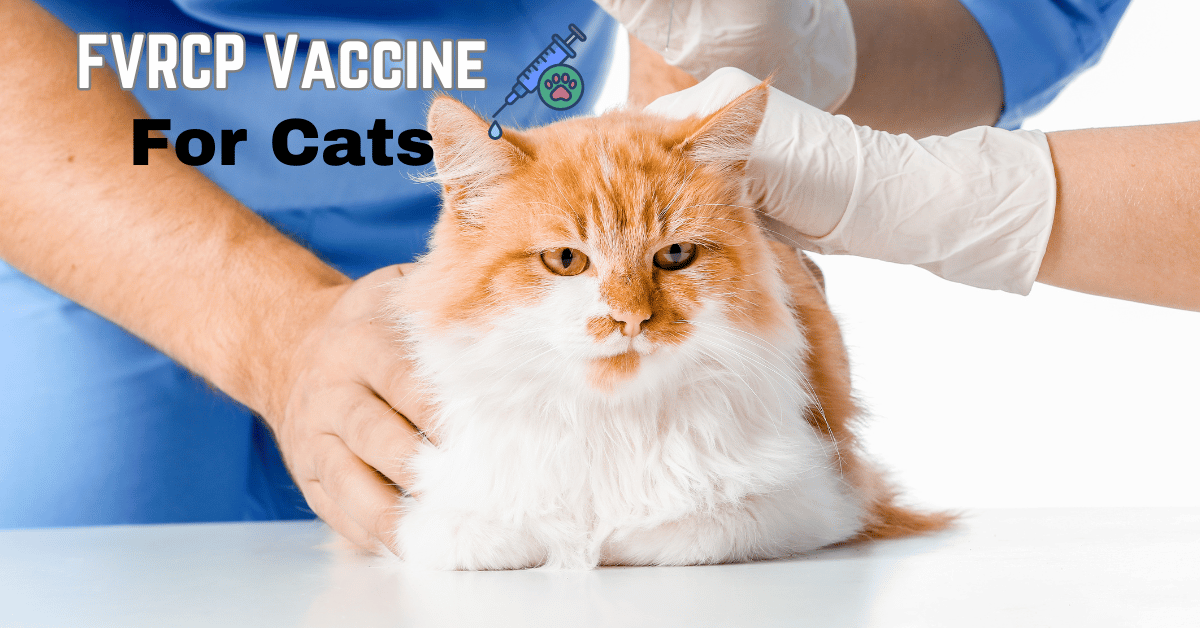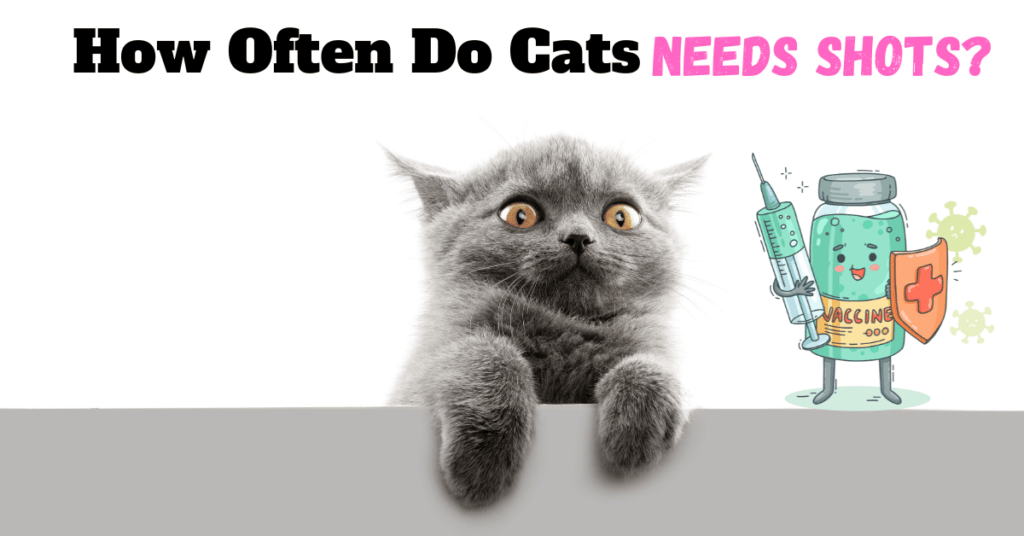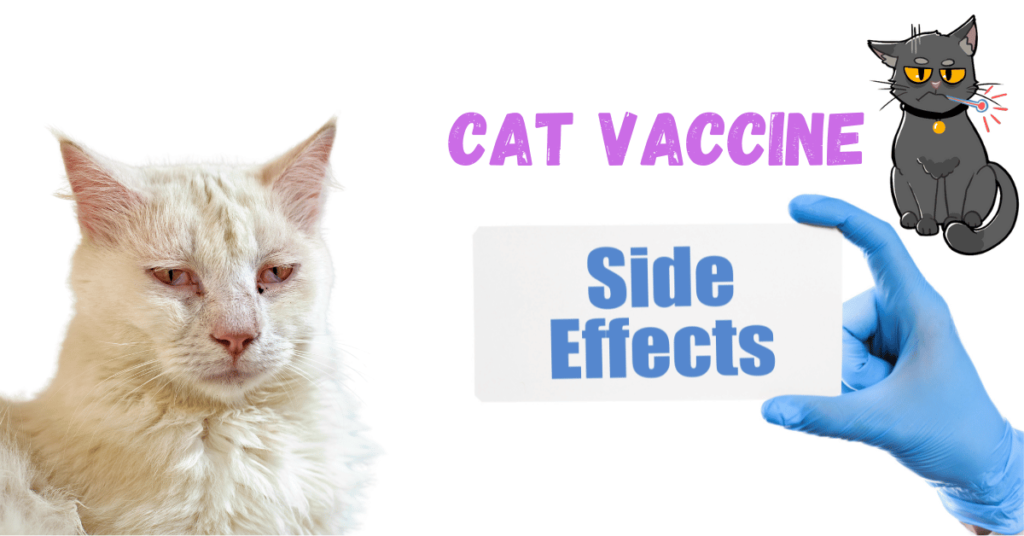This post contains affiliate links and I will be compensated if you make a purchase after clicking on my links.
Why is the FVRCP Vaccine for Cats Essential?
The FVRCP vaccine, also known as the distemper vaccine, is a fundamental part of your cat’s health regimen and is as important as the rabies vaccine. As one of the core vaccinations recommended by veterinarians worldwide, it plays a crucial role in preventing serious feline diseases.
The FVRCP is a combination vaccine designed to protect against Feline Viral Rhinotracheitis, Feline Calicivirus, and Feline Panleukopenia—diseases that pose significant risks to cats of all ages and lifestyles.
Tip: The FVRCP vaccine is akin to the DHPP vaccine for dogs, providing multi-disease protection. It’s one of the two core vaccines for adult cats and one of three for kittens, alongside Rabies and FeLV vaccines
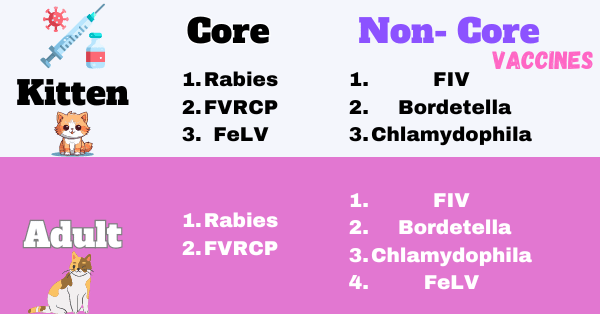
How the Vaccine Works?
When vaccinated, your cat’s immune system learns to recognize these diseases without actually suffering from them. The FVRCP vaccine stimulates the immune system to create memory cells, which remain ready to fight off the diseases more effectively and swiftly if exposed in the future. This process equips your cat with a line of defense that minimizes the chance of severe illness.
Administering this vaccine is recommended for all cats, starting from kittens through to their adult lives, and is crucial even if your cat does not venture outside. By keeping your cat’s vaccinations up-to-date, you’re providing them with the best armor against these common but preventable diseases, safeguarding their health and ensuring their well-being.
The Triple Threat: Diseases Covered by the FVRCP Vaccine
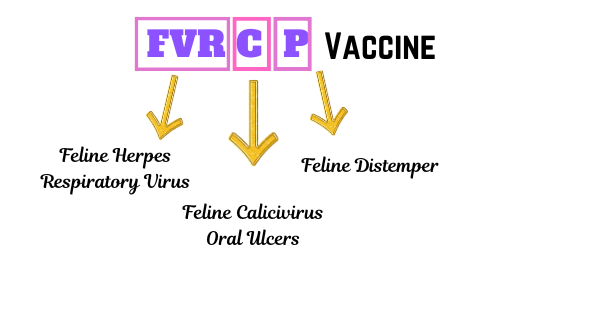
Understanding what the FVRCP vaccine protects against can highlight its importance further:
1. Feline Viral Rhinotracheitis (FVR)
Feline Viral Rhinotracheitis (FVR), caused by Feline Herpesvirus 1, is a major culprit behind respiratory infections in cats, responsible for up to 90% of such cases. This illness can range from mild symptoms like sneezing and a runny nose to more severe issues such as conjunctivitis and keratitis. FVR is particularly troublesome for kittens, older cats, and those with compromised immune systems, as it can cause persistent problems.
In severe cases, symptoms can include depression, loss of appetite, significant weight loss, and sores in the mouth, lasting anywhere from a few days to several weeks. The virus can remain dormant in a cat’s body, posing a risk of re-emergence and making ongoing vigilance essential.
2. Feline Calicivirus (FCV)
Feline Calicivirus (FCV) primarily impacts the respiratory system but is notorious for causing painful ulcers in the mouth and on other facial areas. This virus can present a range of symptoms, from mild respiratory issues to severe conditions such as chronic stomatitis, pneumonia, and even systemic infections.
In more severe strains, FCV can lead to lameness, substantial weight loss, fever, and swollen lymph nodes. The variability in symptoms can drastically affect a cat’s quality of life, potentially resulting in fatal outcomes if the infection spreads to internal organs.
3. Feline Panleukopenia (FPV)
Feline Panleukopenia (FPV), also known as feline distemper, is a highly contagious and dangerous virus with a significant mortality rate. FPV aggressively attacks the body’s cells, particularly in the intestinal tract and bone marrow, leading to severe health issues such as anorexia, vomiting, high fever, and severe diarrhea.
The destruction of bone marrow cells results in a drastically low white blood cell count, which impairs the cat’s ability to fight infections. Consequently, cats with FPV often suffer from secondary infections due to their weakened immune systems, compounding their health challenges. This virus is notorious for its swift progression and severe impact on a cat’s overall health.
Key Insights on FVR, FCV, and FPV Transmission
All three viruses—FVR, FCV, and FPV—are highly contagious. FVR and FCV spread through sneezes, saliva, or eye secretions and can linger on environmental surfaces like bedding or bowls.
FPV, the notorious parvovirus, primarily spreads through contact with contaminated feces and can survive up to a year on various surfaces, meaning your cat doesn’t even need direct contact with an infected cat to catch it.
Quick Tip: Cats with weaker immune systems, like the very young, the elderly, or those with health issues, are more vulnerable to viruses.
FVRCP Vaccine Schedule: Timing and Frequency
To keep these viruses at bay, it’s important to follow a specific and timely vaccination schedule that’s essential for your cat’s health.
Kittens: The Initial Setup
Starting their lives with strong protection, kittens should receive their initial FVRCP vaccination between 6-8 weeks of age. They’ll continue to get booster shots every 3-4 weeks until they are 16-20 weeks old. These boosters are crucial as they build immunity at a time when the natural protection from their mother’s milk starts to decrease.
Adults: Keeping the System Secure
After completing the initial series, kittens need a booster at one year to reinforce their immune defenses. Following this, the general guideline is to administer the FVRCP vaccine every one to three years.
Not all components of the vaccine require boosting at the same frequency—typically, two of the three diseases covered may need annual boosters depending on the vaccine brand used, while the third disease may only require a booster every third year.
Side Effects of the FVRCP Vaccine for Cats
The FVRCP vaccine may cause mild side effects in some cats, though these reactions are usually minimal and temporary.
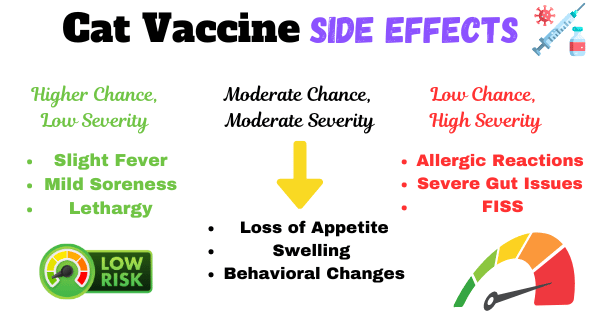
Common Reactions
Post-vaccination, your cat may experience a low-grade fever, mild sluggishness, or reduced appetite. You might also notice slight swelling at the injection site – these symptoms typically resolve within a few days.
Rare Reactions
Although uncommon, some cats can exhibit more serious reactions that require immediate attention. This includes significant swelling at the injection site, hives, respiratory difficulties, or other severe symptoms such as vomiting, diarrhea, and itchiness. Such reactions might occur shortly after vaccination or even up to 48 hours later.
This small, precise dose of about half a milliliter, delivered via a fine needle, is generally well-tolerated, with most cats barely noticing the administration. However, staying alert to these potential side effects will help ensure your cat recovers smoothly and continues to thrive.
Quick Tip: Persistent swelling at the injection site, lasting more than three weeks, should be evaluated by your vet.
Cost of FVRCP Vaccination
The cost of the FVRCP vaccine can vary depending on several factors, such as geographic location, the type of vaccine (adjuvanted or non-adjuvanted), and the veterinary clinic. Generally, you can expect to pay between $30 to $70 per dose.
Non-adjuvanted vs. Adjuvanted Vaccines
When considering the FVRCP vaccine for your cat, it’s important to understand the distinction between adjuvanted and non-adjuvanted vaccines. Adjuvants are substances added to some vaccines to enhance the immune response. However, these adjuvanted vaccines can carry a small risk of causing vaccine-site sarcomas, a type of tumor that can develop at the injection site.
Non-adjuvanted vaccines, on the other hand, do not include these adjuvants. They are often recommended to reduce the risk of such tumors and are considered a safer choice for your cat’s long-term health.
While non-adjuvanted vaccines are generally more expensive, they are preferred for their safety profile, especially in minimizing rare but serious side effects.
Wrapping Up: FVRCP—A Vital Update for Your Cat’s Health
In essence, the FVRCP vaccine is indispensable in your cat’s healthcare routine. By keeping up with vaccinations, you’re not only safeguarding your furry friend but also bolstering their defenses against some of the most prevalent and dangerous feline diseases. Remember, whether for humans or felines, prevention is always the best approach.
It’s important to maintain an updated record of your cat’s vaccinations and ensure regular vet check-ups. Your veterinarian will provide personalized advice tailored to your cat’s specific health needs, age, and lifestyle, helping to optimize the vaccination schedule.
Meet Sean, a fintech whiz with a penchant for pet purrs and blockchain buzz. After a decade of fintech feats, Sean’s tech talents leaped from ledger lines to litter lines, driven by a passion for pets and a vision for a more connected pet care community. With three critter companions as co-pilots, Sean launched this blog to share a treasury of pet-friendly tech tips and tales.

